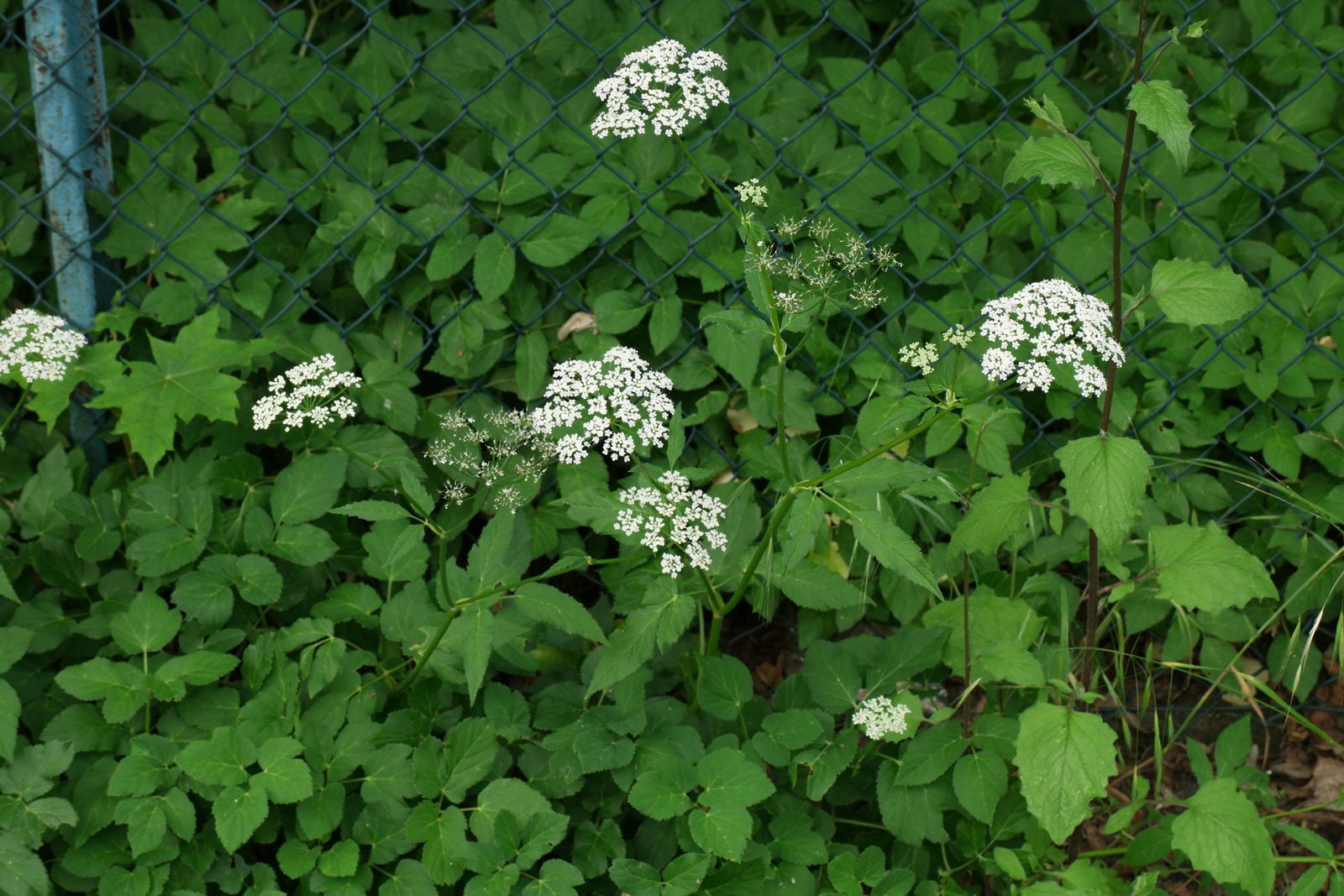I love lots of plants people call weeds (see my book) but there are some plants that can be problematic in gardens and worth removing, such as ground elder, Aegopodium podagraria. Ground elder is a beautiful plant, with attractive green leaves and white umbels of flower that look like short cow parsley in early summer. In our new garden we have a 4m x 5m patch of ground elder which some might see as a bad thing, but I’m over-the-moon as I can now test and demonstrate what organic methods work to remove it (or not!)
Goutweed also known as bishop’s weed or snow-on-the-mountain is an invasive perennial plant that can quickly take over gardens and landscapes. Native to Europe and parts of Asia, goutweed was introduced to North America as an ornamental plant. With its attractive white flowers and lush, variegated foliage, it can provide nice groundcover. However, goutweed spreads aggressively via underground rhizomes and can displace other plants. Getting rid of goutweed takes time and diligence, but it can be done through various mechanical and chemical control methods.
Identifying Goutweed
Goutweed is a member of the carrot family and has characteristic parsley-like leaves that are divided into three leaflets The leaves are typically bluish-green with serrated edges, but variegated varieties have white margins Goutweed forms a dense mat of foliage 6-8 inches tall and spreads by fleshy underground rhizomes that can extend 8 feet or more in all directions.
In late spring, goutweed sends up flower stalks 1-3 feet tall topped with umbrella-shaped clusters of small white flowers. It thrives in moist, partly shaded areas but tolerates a range of light and soil conditions. Goutweed displaces native plants and its dense root system degrades soil health. It is banned as an invasive plant in some U.S. states.
Removing Goutweed by Hand Digging
For small patches, repeatedly digging up all roots and rhizomes is effective. Use a shovel to dig at least 6 inches below the rhizome mat and 12-18 inches beyond visible growth. Remove and discard all roots and soil. Monitor for regrowth, digging up any resprouts. This labor-intensive method works best for small areas. Be extremely thorough since any remnants left behind will resprout.
Smothering Goutweed
Smothering large patches with tarps or heavy black plastic can suppress goutweed by blocking light and reducing growth. Anchor down the edges and leave covered for at least one growing season. Any remaining roots and rhizomes will need to be dug up. This is less effective than removing the entire plant but can help control large infestations when digging is impractical.
Repeated Mowing
Frequently mowing or cutting back goutweed to ground level can help weaken it over time by preventing photosynthesis. Use a mower on the lowest setting to cut any foliage twice weekly and prevent regrowth. This won’t kill goutweed but can slow its spread. Follow up by digging or smothering to finish eradicating.
Flame Weeding
A propane torch can be used to burn back goutweed foliage to ground level. Repeatedly torch any regrowth to starve the roots until the infestation is under control. This is less reliable than digging but avoids herbicides. Combine with digging and mowing for best results. Take safety precautions when flame weeding.
Herbicides
Non-selective herbicides containing glyphosate are effective at killing goutweed. Treatments will likely need to be repeated over one or more growing seasons. Be cautious of harming desired plants. Always follow label directions. Vinegar-based herbicides provide organic control but typically require repeat applications.
Prevention and Alternatives
Avoid planting goutweed, even variegated forms. Choose native groundcovers like golden alexanders or Canada anemone instead. Control new invasions quickly before they spread. Combining digging, mowing, smothering, and herbicides provides the best chance of eradicating goutweed. Be persistent and expect the process to take time. Stopping goutweed from establishing is much easier than removing established infestations.
Getting rid of invasive goutweed takes commitment but is possible through a combination of control methods. Hand digging, mowing, smothering, torching, and herbicides can all help combat goutweed. Using several techniques together provides the best chance of success. Be persistent and don’t let small patches go unchecked, or goutweed can rapidly spread out of control. With dedication, you can reclaim your landscape from this troublesome invader.

The problem with ground elder
Early spring shoots and roots of ground elder, Aegopodium podagraria. The roots spread quite shallowly horizontally beneath the soil surface and can regenerate from the tiniest fragment.
Unfortunately, ground elder spreads by underground rhizomes, horizontal roots with shoots, that spring up creating a dense mat that blocks out many plants of the same size. Eventually it will kill other perennials by taking light, water and nutrient, creating a monoculture of less value for wildlife and less interesting for us. It is a vigorous grower that will shoot from the tiniest bit of root and spreads rapidly.
Join my weekly newsletter for organic gardening tips
It grows between the roots of other plants making it hard to remove from between them. All in all, this is not a plant I would recommend in your garden, or the main bit of garden if you have a larger plot. If you love ground elder to bits, by all means grow it of course.
Update: 16 September 2022
The size of the patch hasn’t seemed to really expand through summer, above ground at least! Hoeing off new shoots around the patch has so far appeared to work to contain it. The Tagetes minuta (Mexican marigold) has had no impact whatsoever. During very dry patches of summer the ground elder noticeably wilted before any other plant, suggesting it will struggle and potentially become less of a pain in future years. But watch out for other plants taking its place that love the drier conditions!
How to remove Ground Elder – Bishops Weed – Goutweed (Aegopodium podagraria) using SoilWand
0
